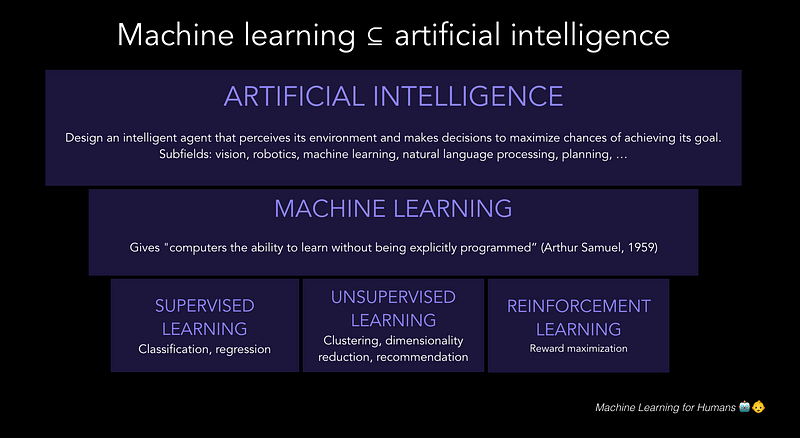Roadmap
Part 1: Why Machine Learning Matters. The big picture of artificial intelligence and machine learning — past, present, and future.
Part 2.1: Supervised Learning. Learning with an answer key. Introducing linear regression, loss functions, overfitting, and gradient descent.
Part 2.2: Supervised Learning II. Two methods of classification: logistic regression and SVMs.
Part 2.3: Supervised Learning III. Non-parametric
learners: k-nearest neighbors, decision trees, random forests.
Introducing cross-validation, hyperparameter tuning, and ensemble
models.
Part 3: Unsupervised Learning. Clustering:
k-means, hierarchical. Dimensionality reduction: principal components
analysis (PCA), singular value decomposition (SVD).
Part 4: Neural Networks & Deep Learning.
Why, where, and how deep learning works. Drawing inspiration from the
brain. Convolutional neural networks (CNNs), recurrent neural networks
(RNNs). Real-world applications.
Part 5: Reinforcement Learning. Exploration
and exploitation. Markov decision processes. Q-learning, policy
learning, and deep reinforcement learning. The value learning problem.
Appendix: The Best Machine Learning Resources. A curated list of resources for creating your machine learning curriculum.
Who should read this?
- Technical people who want to get up to speed on machine learning quickly
- Non-technical people who want a primer on machine learning and are willing to engage with technical concepts
- Anyone who is curious about how machines think
This
guide is intended to be accessible to anyone. Basic concepts in
probability, statistics, programming, linear algebra, and calculus will
be discussed, but it isn’t necessary to have prior knowledge of them to
gain value from this series.
Why machine learning matters
Artificial
intelligence will shape our future more powerfully than any other
innovation this century. Anyone who does not understand it will soon
find themselves feeling left behind, waking up in a world full of
technology that feels more and more like magic.
The rate of acceleration is already astounding. After a couple of AI winters and periods of false hope
over the past four decades, rapid advances in data storage and computer
processing power have dramatically changed the game in recent years.
In
2015, Google trained a conversational agent (AI) that could not only
convincingly interact with humans as a tech support helpdesk, but also
discuss morality, express opinions, and answer general facts-based
questions.

The same year, DeepMind developed an agent
that surpassed human-level performance at 49 Atari games, receiving
only the pixels and game score as inputs. Soon after, in 2016, DeepMind
obsoleted their own this achievement by releasing a new state-of-the-art gameplay method called A3C.
Meanwhile, AlphaGo
defeated one of the best human players at Go — an extraordinary
achievement in a game dominated by humans for two decades after machines
first conquered chess. Many masters could not fathom how it would be
possible for a machine to grasp the full nuance and complexity of this
ancient Chinese war strategy game, with its 10¹⁷⁰ possible board
positions (there are only 10⁸⁰atoms in the universe).

In March 2017, OpenAI created agents that invented their own language to cooperate and more effectively achieve their goal. Soon after, Facebook reportedly successfully training agents to negotiate and even lie.
Just
a few days ago (as of this writing), on August 11, 2017, OpenAI reached
yet another incredible milestone by defeating the world’s top
professionals in 1v1 matches of the online multiplayer game Dota 2.

Much
of our day-to-day technology is powered by artificial intelligence.
Point your camera at the menu during your next trip to Taiwan and the
restaurant’s selections will magically appear in English via the Google
Translate app.

Today AI is used to design evidence-based treatment plans for cancer patients, instantly analyze results from medical tests to escalate to the appropriate specialist immediately, and conduct scientific research for drug discovery.

Law enforcement uses visual recognition and natural language processing to process footage from body cameras. The Mars rover Curiosity even utilizes AI to autonomously select inspection-worthy soil and rock samples with high accuracy.
In
everyday life, it’s increasingly commonplace to discover machines in
roles traditionally occupied by humans. Really, don’t be surprised if a
little housekeeping delivery bot shows up instead of a human next time
you call the hotel desk to send up some toothpaste.
In
this series, we’ll explore the core machine learning concepts behind
these technologies. By the end, you should be able to describe how they
work at a conceptual level and be equipped with the tools to start
building similar applications yourself.
The semantic tree: artificial intelligence and machine learning
One bit of advice: it is important to view knowledge as sort of a semantic tree — make sure you understand the fundamental principles, ie the trunk and big branches, before you get into the leaves/details or there is nothing for them to hang on to. — Elon Musk, Reddit AMA

Artificial
intelligence is the study of agents that perceive the world around
them, form plans, and make decisions to achieve their goals.
Its foundations include mathematics, logic, philosophy, probability,
linguistics, neuroscience, and decision theory. Many fields fall under
the umbrella of AI, such as computer vision, robotics, machine learning,
and natural language processing.
Machine learning is a subfield of artificial intelligence.
Its goal is to enable computers to learn on their own. A machine’s
learning algorithm enables it to identify patterns in observed data,
build models that explain the world, and predict things without having
explicit pre-programmed rules and models.
The AI effect: what actually qualifies as “artificial intelligence”?
The exact standard for technology that qualifies as “AI” is a bit fuzzy, and interpretations change over time. The AI label tends to describe machines doing tasks traditionally in the domain of humans. Interestingly, once computers figure out how to do one of these tasks, humans have a tendency to say it wasn’t really intelligence. This is known as the AI effect.
For example, when IBM’s Deep Blue defeated world chess champion Garry Kasparov in 1997, people complained that it was using "brute force" methods and it wasn’t “real” intelligence at all. As Pamela McCorduck wrote, “It’s part of the history of the field of artificial intelligence that every time somebody figured out how to make a computer do something — play good checkers, solve simple but relatively informal problems — there was chorus of critics to say, ‘that’s not thinking’”(McCorduck, 2004).
Perhaps there is a certain je ne sais quoi inherent to what people will reliably accept as “artificial intelligence”:
"AI is whatever hasn't been done yet." - Douglas Hofstadter
So does a calculator count as AI? Maybe by some interpretation. What about a self-driving car? Today, yes. In the future, perhaps not. Your cool new chatbot startup that automates a flow chart? Sure… why not.
Strong AI will change our world forever; to understand how, studying machine learning is a good place to start
The technologies discussed above are examples of artificial narrow intelligence (ANI), which can effectively perform a narrowly defined task.
Meanwhile, we’re continuing to make foundational advances towards human-level artificial general intelligence (AGI), also known as strong AI. The definition of an AGI is an artificial intelligence that can successfully perform any intellectual task that a human being can,
including learning, planning and decision-making under uncertainty,
communicating in natural language, making jokes, manipulating people,
trading stocks, or… reprogramming itself.
And
this last one is a big deal. Once we create an AI that can improve
itself, it will unlock a cycle of recursive self-improvement that could
lead to an intelligence explosion over some unknown time period, ranging from many decades to a single day.
Let an ultraintelligent machine be defined as a machine that can far surpass all the intellectual activities of any man however clever. Since the design of machines is one of these intellectual activities, an ultraintelligent machine could design even better machines; there would then unquestionably be an ‘intelligence explosion,’ and the intelligence of man would be left far behind. Thus the first ultraintelligent machine is the last invention that man need ever make, provided that the machine is docile enough to tell us how to keep it under control. — I.J. Good, 1965
You may have heard this point referred to as the singularity.
The term is borrowed from the gravitational singularity that occurs at
the center of a black hole, an infinitely dense one-dimensional point
where the laws of physics as we understand them start to break down.

A recent report by the Future of Humanity Institute surveyed a panel of AI researchers on timelines for AGI, and found that “researchers believe there is a 50% chance of AI outperforming humans in all tasks in 45 years” (Grace et al, 2017).
We’ve personally spoken with a number of sane and reasonable AI
practitioners who predict much longer timelines (the upper limit being
“never”), and others whose timelines are alarmingly short — as little as
a few years.

The advent of greater-than-human-level artificial superintelligence (ASI) could be one of the best or worst things to happen to our species. It carries with it the immense challenge of specifying what AIs will want in a way that is friendly to humans.
While it’s impossible to say what the future holds, one thing is certain: 2017 is a good time to start understanding how machines think.
To go beyond the abstractions of armchair philosophy and intelligently
shape our roadmaps and policies with respect to AI, we must engage with
the details of how machines see the world — what they “want”, their
potential biases and failure modes, their temperamental quirks — just as
we study psychology and neuroscience to understand how humans learn,
decide, act, and feel.
There are complex, high-stakes questions about AI that will require our careful attention in the coming years. It is our duty to thoughtfully approach these questions from an informed and intentional standpoint.
How can we combat AI’s propensity to further entrench systemic biases evident in existing data sets? What should we make of fundamental disagreements among the world’s most powerful technologists about the potential risks and benefits of artificial intelligence? What are the most promising technical approaches to teaching AI systems to behave themselves? What will happen to human's sense of purpose in a world without work?
Machine
learning is at the core of our journey towards artificial general
intelligence, and in the meantime, it will change every industry and
have a massive impact on our day-to-day lives. That’s why we believe
it’s worth understanding machine learning, at least at a conceptual
level — and we designed this series to be the best place to start.
How to read this series
You
don’t necessarily need to read the series cover-to-cover to get value
out of it. Here are three suggestions on how to approach it, depending
on your interests and how much time you have:
- T-shaped approach. Read from beginning to end. Summarize each section in your own words as you go (see: Feynman technique); this encourages active reading & stronger retention. Go deeper into areas that are most relevant to your interests or work. We’ll include resources for further exploration at the end of each section.
- Focused approach. Jump straight to the sections you’re most curious about and focus your mental energy there.
- 80/20 approach. Skim everything in one go, make a few notes on interesting high-level concepts, and call it a night. 😉
No comments:
Post a Comment